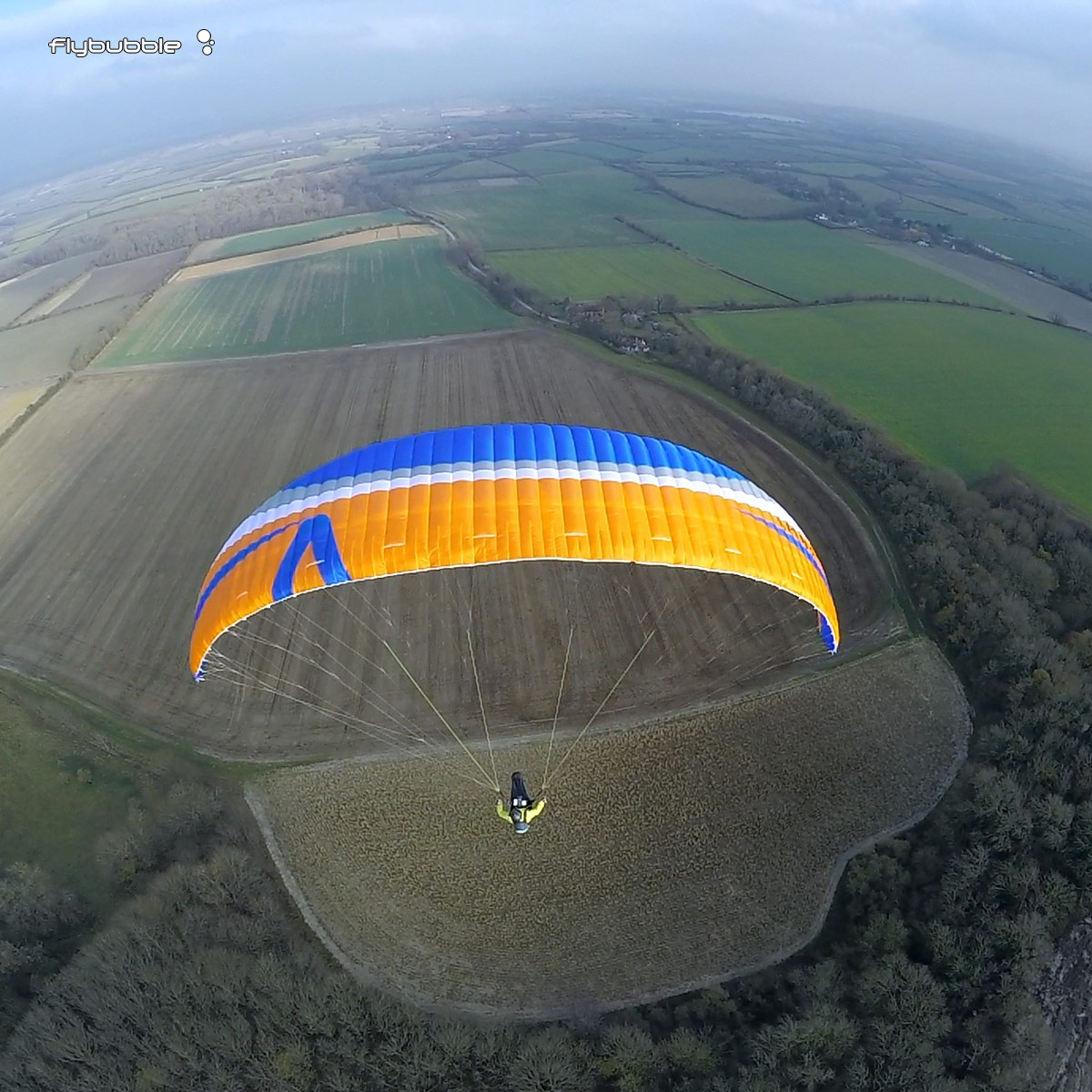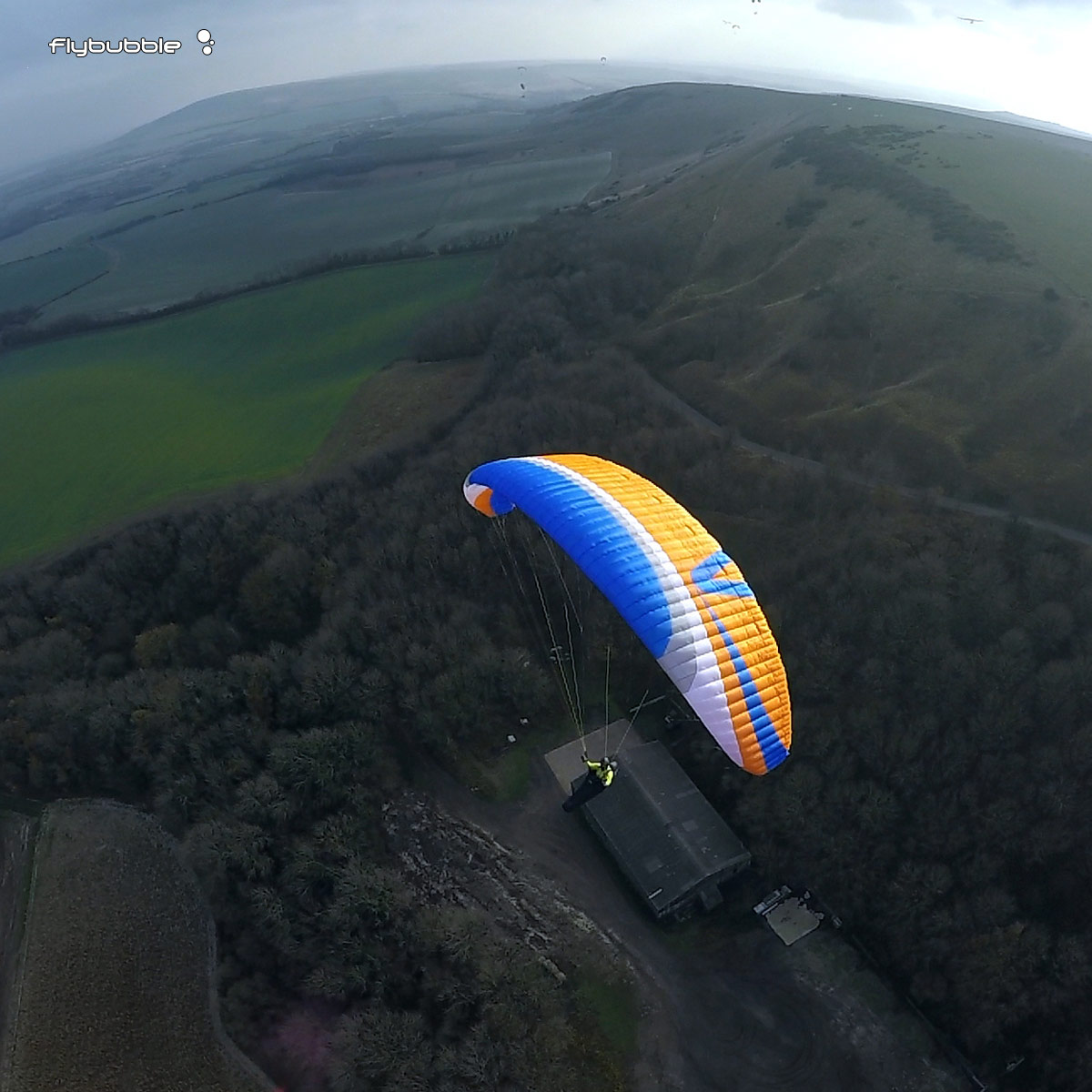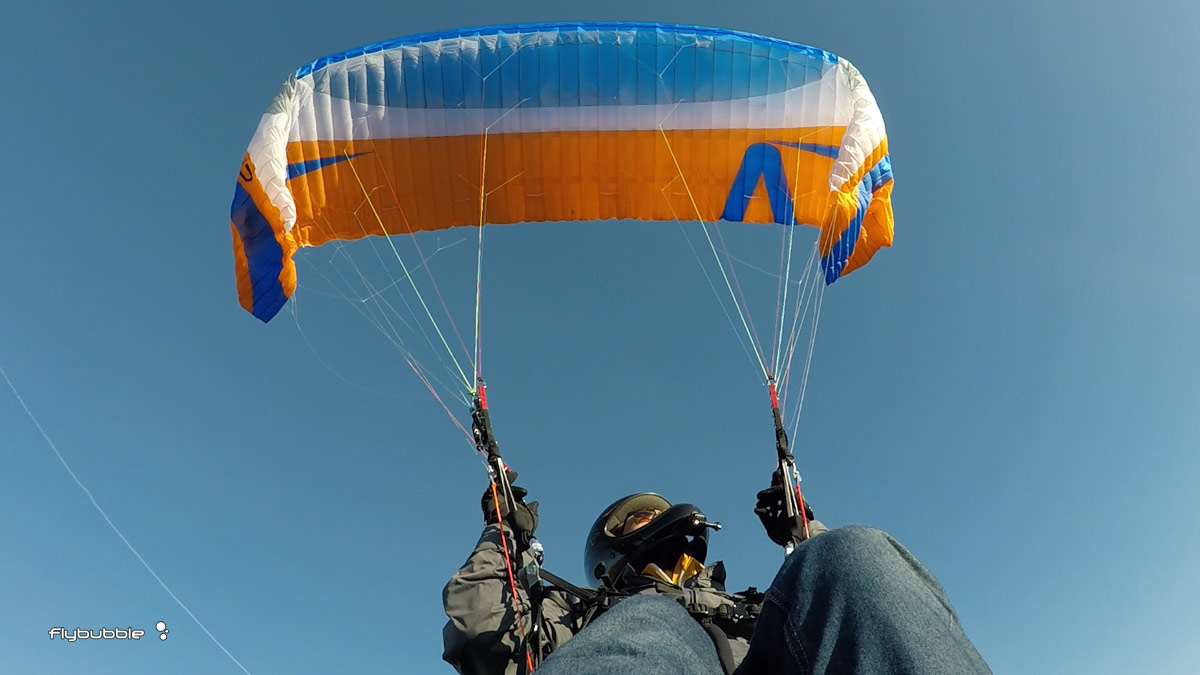
Skywalk have taken almost four years to release the CHILI4, choosing completed development rather than rapid turnover. There was no real hurry. Its predecessor had an enviable reputation as the 'climbing king' in the XC Class. It also had a fairly impressive accelerated glide, making it a favourite in the UK, where escaping from small hills usually involves pushing upwind from a poor climb before making the best of weak lift that struggles through the ground inversion and into the really good sky near the clouds.
The CHILI4 has slightly more aspect ratio (5.6), 6 more cells (57), is slightly heavier and is designed with 5kg more loading. From that I'd expect the wing to be slightly faster and offer better glide. The introduction of a shark nose should increase the speed range and safety. So is it an outright winner? Here are my first impressions in limited winter conditions.

Skywalk CHILI4 on the ground
The risers are the same slim Skywalk design, 'no thicker than necessary' black webbing with poppers, a nice addition of low-friction rings to guide the brake lines which have new chafe-protectors. The maillons are now finished with rubber O-rings instead of the plastic inserts (which prevented maillons opening accidentally) so you'll have to check those in your pre-flights. The outer 'wingtip stack' is now unsheathed. I'd have preferred sheathed lines here because these lines are the ones pilots hook into bushes and obstructions first, but you're getting more sheathed lines than some competitors.
 Carlo holding the CHILI4 down with the C risers: effective and simple.
Carlo holding the CHILI4 down with the C risers: effective and simple.Kiting the wing is simple enough, cross-brakes or As and Cs. If allowed to fall back past 50 degrees, it develops a kink along the Cs which slows the descent, dragging it down in a stall. This will help save the fabric from hard impacts common with failed launch attempts. It's not a characteristic I like in a higher class wing, where it produces too much yaw, but with the lower aspect wing it helps to 'calm down' the wing at low angles, putting it gently back on the ground for a restart. It also slows the pullup, but this does make it a little challenging when kiting upslope as the wing moves in and out of stall - it doesn't 'stay alive' as much as the Chili 3.
 The wing does not refly easily from low angles, it prefers to drop down
The wing does not refly easily from low angles, it prefers to drop downWhen I reviewed the CHILI 3, I wrote "It has a quick, light pullup that is easy to control. It needs a bit of brake at the top or it overflies. Due to the big brake range before stall point, it is easy to groundhandle, but it requires good reactions." Over time, this has proved to be challenging as it demands to be controlled with deep brake input. As the brakes are especially long, this can result in not enough input. Also, pilots at this level can sometimes not have the fastest reaction speeds. What I have noticed is CHILI 3 pilots with overshooting wings which tuck on launch: either the 'pluck, dump' scenario or 'tuck, tip, drag'.
I was hoping the CHILI4 would address this issue. Although it's true the wing pulls up more slowly, when close to vertical the pitch behaviour is at least as lively as the CHILI 3. Although an experienced pilot will have no problem dampening this agility with the responsive, short brakes, those of lesser experience will have to work hard to time their inputs correctly, especially on steeper launches. If the wing is allowed to search ahead of the pilot on the ground, there is remarkably little collapse resistance.
I pulled up in very strong conditions and had no difficulties. Overall not the easiest wing to ground handle, but within reach of most pilots with a bit of practice.

Skywalk CHILI4 in the air
With what looks like a reduced camber (slimmer aerofoil) and introduction of a 'decent shark nose', it's a different wing to the Chili 3, which was soft, gentle and 'floaty'. The CHILI4 is more firm and responsive, just as smooth and calming on the roll axis, and somewhat reminiscent of Tequila 4 in the way it rounds off the edges of the bumps.
 A 'decent shark nose' looks like this, with set-back As.
A 'decent shark nose' looks like this, with set-back As.Regarding active piloting demands, I have to repeat what I wrote about the CHILI 3: "Although it has some passive stability, pitch control requires intelligent active piloting. This means you have more agility, but also that it can become demanding in rough conditions." Ditto.

The CHILI4 pitches easily if the pilot encourages it to, and does not seem to dampen the pitch energy out significantly. It's quite a contrast to something like the Tequila 4. If left to dive far ahead of the pilot, it will collapse. Closer to vertical, it absorbs turbulence well enough. It will take some time to develop the feeling of which pitches to leave and which ones to actively dampen out.
I tried another favourite reviewer trick, slightly sloppy wingovers, and got an outside wing collapse as a reward. Yes it's numpty piloting, but not every pilot who climbs aboard an EN B wing is gifted, and some are just good fellows out flying on a bad day. The wing itself can absorb knocks, but a nervous pilot can escalate the severity of the turbulence rapidly on this wing.

The combination of these two traits (pitch not dampened, nose not especially resistant when pitched forward) makes me reserved about recommending it to recreational pilots with limited airtime. It is at the top of the XC class in terms of pilot demands. It remains to be seen if the gains in performance are worth the compromise in simplicity.

Speedbar
Skywalk boasts of 'near comp wing highspeed gliding'. Although the bar travel is very long, the top speed might hover just above 52 (compared to 65+ of a modern comp wing). I don't expect the accelerated glide to be close either. Carlo felt that the wing was a bit unstable on the last few cm of full bar. I tested this behaviour by pulling the pulleys together and wriggling as much as I could: the wing remained solid for me (in smooth soaring conditions). A 'character' is a hard thing to define, so we've shared both our opinions here. An effective, light speedbar for sure, at the top end of this class, but not comparable to comp wings. Let's keep it real.

Thermaling
The Chili 3 had a smooth, efficient flat turn, but if you wanted to hook it around tightly you had to use a huge brake input. There is a marked change in the CHILI4. The brakes are now set at completely the other end of the scale, one of the shortest brake settings in the class, with about 15cm of slack before the direct brakes with medium pressure engage. Depending on your technique you might have to be careful on reverse launching that you don't separate your hands too much as the short brakes could begin to pull the trailing edge.
 Stall point! Now easier to reach, but no cause for alarm, as the pressure gets really high
Stall point! Now easier to reach, but no cause for alarm, as the pressure gets really highChili 3 pilots will require retraining their muscle memory! The wing is fairly agile, without dropping the inside tip. It turns from around the third-of-span position, so it never 'hooks' into a corner. Despite that, I found it easy to get fast circling in thermals. I look forward to flying the CHILI4 in sporty summer conditions. I expect the thermaling pleasure and efficiency will emerge.
 Brakes deflect most about a third along the span (more near the centre) keeping turns flat
Brakes deflect most about a third along the span (more near the centre) keeping turns flatOn landing, the wing has moderate brake pressure throughout the range. When your hands get to about the seatboard, you get a reassuring wall of resistance before stall point.
Handling
It is suited to a similar kind of pilot to the Chili 3. Whereas on the Chili 3, the feedback from the wing was sometimes so light and subtle that it was hard to anticipate its movements, the CHILI4 has more 'connected' feedback.
It responds quickly to brake input, without being direct (it doesn't have the sharp agility of the Tequila 4). It has a smooth, calm turn that generates little energy, and quickly dissipates any roll, making it simple and reassuring to fly. A little bit of care is required when forcing a tight turn, as the spin point can be easily reached in a corner and it generates a slipping rotation. There's little need for such a heavy-handed approach because the turn is usually fast and tight.
It's probably difficult to get the design balance right: not too dull (but safe), not too agile (but lively). Although I've criticised the pitch freedom elsewhere, that same pitch energy is nice to have on tap. It makes the wing come alive: that little boost you can give to your speed before a turn, the way the wing will search into a thermal. It's often part of the delight of moving up a class. To me, the CHILI4 feels smooth and sporty.
Safety
The wing is certified EN B, so collapse recovery is not in question. I did find the collapses more energetic than the Chili 3, both asymmetrics and frontals. Big ears were simple to engage with the split A risers, and produced small tip folds with moderate sink rate. By pulling the lines inwards and downwards I could encourage slightly more, but felt I needed to re-apply the manouevre using 2 A lines per side to get significant results. It was stable either way.

Skywalk CHILI4: First impressions
There are two kinds of pilots in the XC Class. Those who are moving up on the exhilarating trajectory from their Progression Class wing, on their way to site records and competition successes. And those who, with years of experience, choose the 'high B' category as the wisest compromise between performance and safety. I feel that the Skywalk CHILI4 is most suited to this second group of pilots, where the piloting style required naturally matches their experience. Also pilots moving 'across and slightly up' from the Chili 3. It's not as well-matched to first timers in the XC class.
I don't like the little kick it still has around vertical combined with the 'nose that goes', which might catch pilots out during tricky launches, especially considering how the wing can be slow at first (requiring extended pulling on the As) then quick (you must release at just the right time).
I prefer the new big-ears setup, which are less flappy, simpler and less stall-prone (great) but don't produce as much descent unless you reach for the second A line.
I like the set-back As and shark nose, which should combine to produce more collapse resistance when airborne by greater tolerance for changes in angle of attack. The increased loading helps to gain solidity. I like the tight, rotating turn that is responsive and will be superb at maximising climb rate in most thermals. I love the short brake setting that allows you to use the best part of control power, while allowing full travel down to seat board for stall.
It's a modern design that will perform at the top of the class but could be more than some pilots are ready for. There are no obvious weaknesses in the wing: this review has highlighted where the gaps in pilot ability are most likely to be found. With correct skill, training or practice, the Skywalk CHILI4 can be the mile-munching explorer you need with pleasing handling and a bit of spice.

TECH-SPECS COMPARISON (XC CLASS)
|
CHILI4 |
IOTA |
MENTOR 4 |
IKUMA |
|
|
Flat surface (m2) |
26.4 |
26.0 |
26.1 |
24.5 |
|
Aspect ratio |
5.65 |
5.5 |
5.4 |
5.7 |
|
Certified takeoff weight (kg) |
85-105 |
75-100 |
80-100 |
80-100 |
|
Number of cells |
57 |
59 |
55 |
57 |
|
Glider weight with std risers (kg) |
5.5 |
4.85 |
5.3 |
4.85 |
Reviewed by Greg Hamerton 26 Nov 2016
CHILI4 S flown with Sup'air Strike harness (ultralight pod) at 93.5kg (85-105) for 2.5 hours in strong winter soaring conditions with occasional thermals at 200m ASL, 11 degrees C, and 1 hour in light wind soaring conditions at 200m ASL, 13 degrees C.
We later published another, more in-depth review of the Skywalk CHILI4 in April 2017 after a good amount of testing in spring thermic conditions, which we think is definitely worth reading after this winter first impressions review.
More info on the Skywalk CHILI4
Want to see more?
There's no better way to support our efforts than buying kit from us. We'll ensure you get great service! Choose from our huge range AND enable us to produce more videos and articles to benefit the freeflight community.

